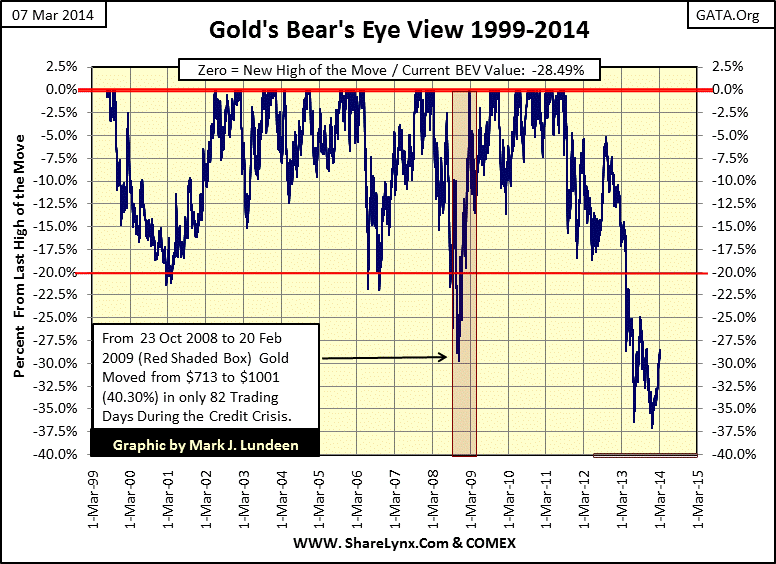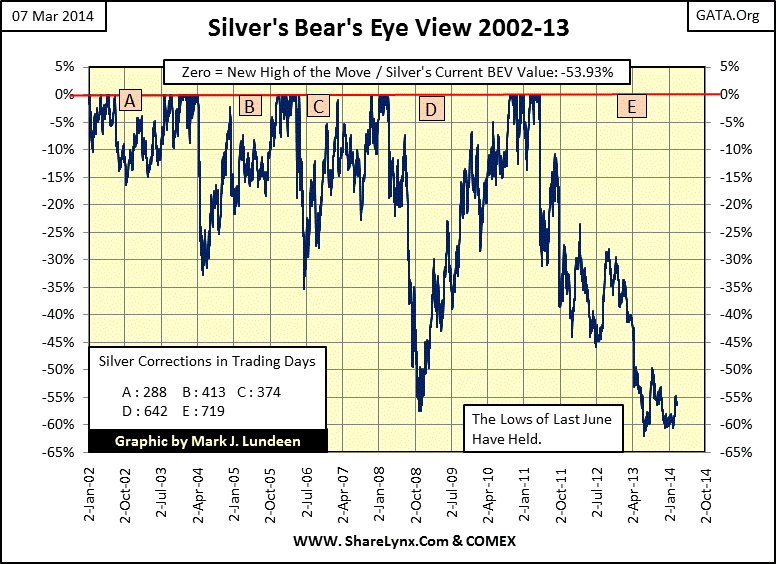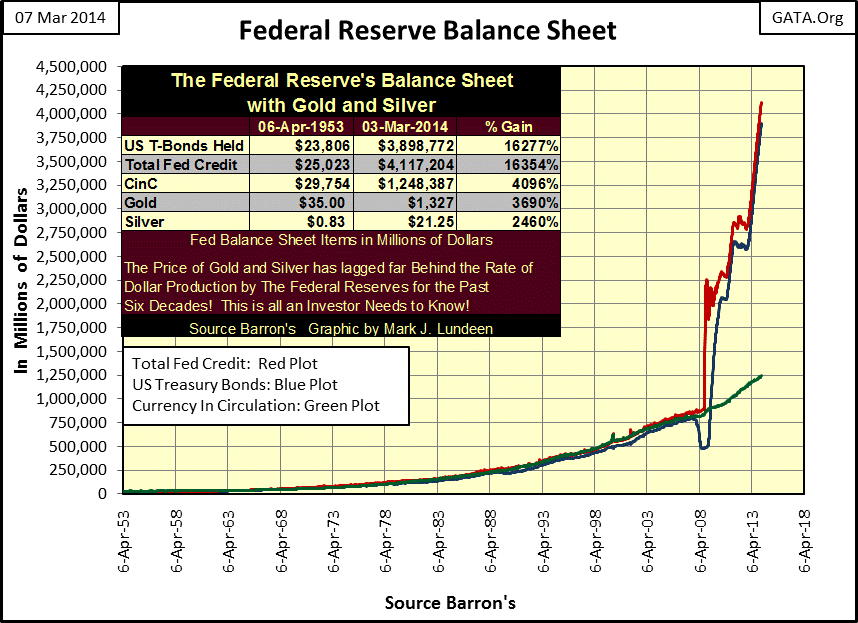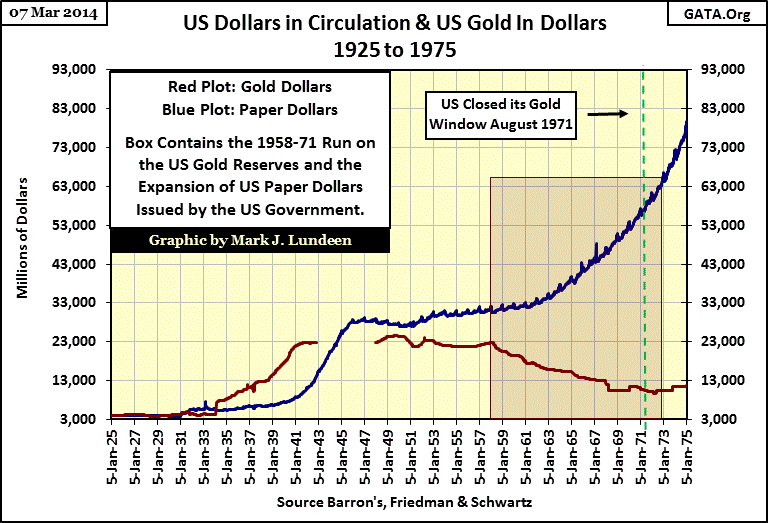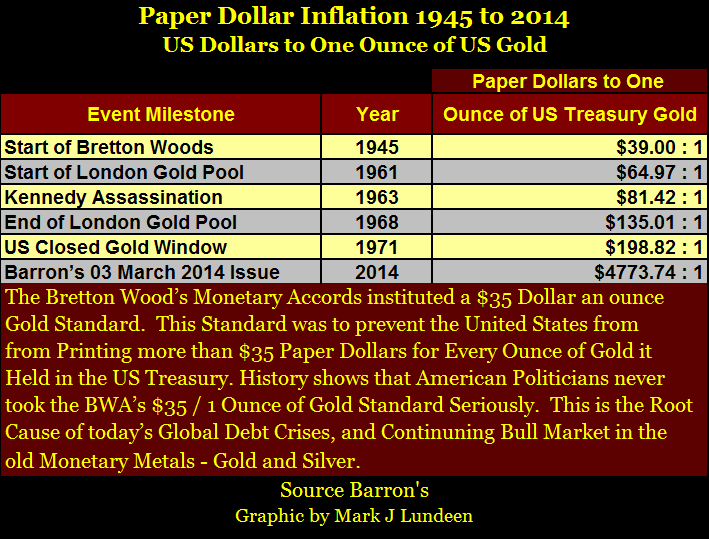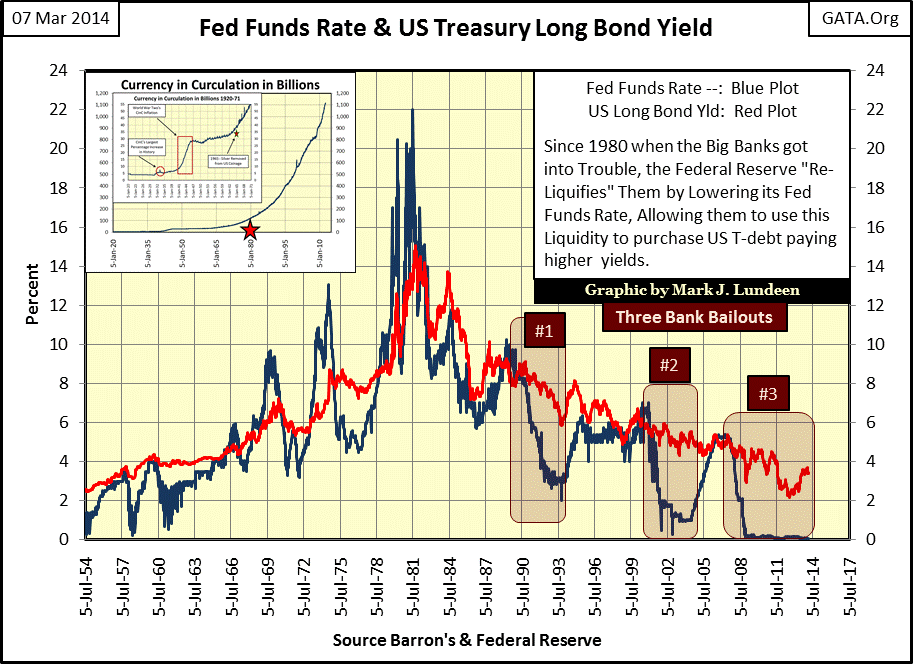The Best Is Yet To Come For Gold And Silver

The gold and silver markets saw a little excitement early this week when the Obama administration announced it intended to freeze Russian assets if President Putin didn’t withdraw Russian troops from Ukraine. But not enough excitement to cause a noticeable change in gold’s BEV plot below, even after Putin threatened to sell Russia’s US Treasury bonds and other US assets. Up until the close on Friday, the price of gold remained about 29% below its record highs of August 2011, where it’s been for the past three weeks. I had expected a more significant gain from an announcement of a central bank considering selling their US Treasury bonds during a time of international unrest. But Russia’s central bank is only the eleventh largest holder of US Treasury bonds.
http://www.treasury.gov/resource-center/data-chart-center/tic/Documents/mfh.txt
As of December 2013 Russia had only $138 billion in US Treasury bonds, less than two months of QE purchases by the Federal Reserve. On Friday morning, Washington and Wall Street once again rapped the knuckles of the precious metals bulls with another sell off in gold and silver. But all they accomplished was to erase the gains made earlier in the week, leaving gold slightly higher and silver slightly lower than last week’s close.
Same story in the silver market.
The Ukrainian story has more significance than just its potential impact on my investments. I do have sympathy for Ukraine, but the situation there is more complicated than reported by the US news media. For all the hours of coverage generated they somehow manage to keep the story superficial. Here’ a link to a Christian web site that has a superb historical perspective on the history of central Europe’s shifting political boundaries and their impact on the current Ukrainian-Russian situation. See the daily updates for March 4th, 5th and 6th to better understand why passions are running so high in the countries of the former Soviet block. All three updates together take about a half hour to watch, and are well worth your time.
http://www.prophecyinthenews.com/category/daily-update/
Still, in a world where China alone has been purchasing more gold than total global production over the past year, and where the Federal Reserve has refused to allow Germany to seek its 1,500 tonnes of gold lost somewhere in the basement of the NY Federal Reserve bank, current gold prices are a puzzle. The Federal Reserve has only returned 5 tonnes of it after promising to return 50 tonnes a year for the next seven years. If I was Germany, I’d color that gold gone. These were, and still are big stories that should have had bullish implications for the price of gold in 2013, instead the price of gold crashed last year. So, what will it take to see gold and silver resume their bull markets? I haven’t a clue, but I do know that gold and silver are in a bull market because the United States’ monetary policy since World War II has been consistently to overprint and devalue the dollar relative to the amount of national gold reserves. Countries in Asia and elsewhere have begun to settle their trade accounts between themselves using currencies other than the US dollar.
Can you blame them? Look at what the Federal Reserve has been doing to the US dollar below, monetizing garbage debt to keep the US banking system’s toxic assets liquid and Treasury bond yields artificially low. No one but the Federal Reserve purchases US mortgages in bulk anymore. How anyone can be bearish on the old monetary metals when the publisher of the global reserve currency continually does this to its currency is beyond me. Look how far the plots below have advanced since April 2013, just a year ago with no sign of slowing down.
Below are plots of central bank holdings of US Treasury bonds as a percent of the US National debt. As a rule, the Federal Reserve (Blue Plot) never reduces its portfolio of US Treasury bonds. So it’s best to understand the increases in the blue-plot as those times when the Fed was “monetizing” US Treasury bonds faster than Congress increased the national debt, and decreases in the plot as those times when Congress was increasing the national debt faster than the Fed was “monetizing” it. I’m someone who frequently criticizes the Federal Reserve’s monetary policy, but the Federal Reserve is only the political creation of the US Congress. It’s the Congress’ refusal to live within the means of the taxpayers that’s the actual root cause of the US dollar’s problems, and the continuing bull market in gold and silver.
The post high-tech bust increase in foreign central bank holdings of US Treasury bonds is interesting. The high tech bubble was a global phenomenal. In the 1990s everyone in the world believed Microsoft and Intel were going to make them rich. In the aftermath of the high-tech bubble foreign central banks (Red Plot) monetized 25% of the US national debt to aid the Federal Reserve in “restoring normality” to the global financial system. In the process these banks also inflated a gigantic bubble in their own real estate markets from 2000 to 2007 just as the Federal Reserve did in the US. It’s also worth noting how by 2008, foreign central banks had monetized 25% of the American national debt, but had found their limit. This event, foreign central bank refusal to monetize 26% and then more of America’s national debt, marked the starting point of the Federal Reserve’s quantitative easing programs (Red Box above). So far, the Federal Reserve has yet to find its limit in monetizing the ever expanding US national debt, and it’s unlikely they ever will as long as the US dollar remains the global reserve currency.
The seeds of the 1970s gold bull market were sown by the Federal Reserve “monetary policy” of the 1960s as it increased its portfolio of US Treasury bonds from 8% of the national debt in 1955 to 17% in 1973. This was done in a world that still fondly remembered the gold standard; when money was mined from the ground. The 1950s and 60s were times when wealth resented the Federal Reserve recklessly creating new debt-backed dollars. America’s trading partners became upset with Washington’s inflationary ways. As seen below, a run on the US gold reserves began in 1958 that didn’t end until President Nixon “temporarily” closed the US Treasury’s gold window in August 1971. It can never reopen, as evidenced by the failure of the US last year to return any more than 5 tonnes of Germany’s gold out of the 1500 total tonnes it supposedly holds. It will be interesting to see how many tonnes are returned this year.
After August 1971 the US Treasury never resumed the Bretton Wood’s $35 an ounce standard as was their legal responsibility. This was the second default by the US Treasury on the dollar, after it removed all gold coin from circulation in 1933, and devalued the dollar from 20.67 per ounce of gold, to 35 per ounce of gold in 1934. The Federal Reserve continued to print ever more paper dollars after 1933. By August 1971 the US Government had already issued $198.82 paper dollars for every $35 of gold (or one ounce of gold) held by the US Treasury. Now in March 2014, there are currently $4,773.74 paper dollars in circulation for every ounce of gold the US Treasury claims it holds. The US gold reserves has not been audited since 1954, and a bill introduced by Ron Paul to audit the gold held in Fort Knox was defeated, so we know the Congress knows exactly what’s going on. This reckless behavior by the US government and the academics who manage “monetary policy” for the global-reserve currency will devastate the global economy someday - if not today.
It’s important to understand that the Bretton Woods Accords are still the law of the land. The International Monetary Fund and World Bank (BWA institutions) still have legal standing in the United States; only those clauses that prohibit the creation of paper currency in excess of gold held by the US Treasury are ignored.
This willful disregard for law has had profound effect on financial markets. Since the 1950s when the US Treasury and Federal Reserve first began issuing more paper dollars than they were legally authorized to do, long and short term interest rates have seen periods of chaos that lasted decades. In the chart below we see US Treasury bond yields (Red Plot) increasing from 2.5% in 1954 to over 15% in 1981 with the Fed Funds rate peaking at over 21%. In these three decades wealth supposedly preserved in the bond market to support retirees, widows and orphans was devastated by inflation to finance American political ambitions and social programs that only seem to perpetuate poverty.
I like the following quote from a popular 1950s television show, made a year before the 1958-71 run on the US Treasury’s gold reserves began:
“The real problem with retiring is money. Most people save their whole lives to retire in the same style they enjoyed when they were working, only to realize that they can’t live like they used to even while they’re still working. You see these ads for retirement and they always have fishing boats in the background. That is because for $120 a month, fishing is the only way retired people can feed themselves.
- George Burns: George Burns and Gracie Allen Show Season 8 Episode 9, 1957
I believe history will prove the current debt market is more chaotic than it was from 1954 to 1981. After the three US bank bailouts noted in the chart above:
- Japanese Real Estate and Stock Market Bubble
- High-Tech Bubble
- US Real Estate Bubble
when the Federal Reserve responded to the deflating bubble by manipulating the US yield curve by sharply lowering the Fed Funds rate (Blue Plot above) and monetizing toxic debt for the benefit of irresponsible bankers. There’s going to be hell to pay for what Greenspan and Bernanke did, and the US bond market is going to be ground zero. We can see the coming day of reckoning in the chart below.
For the two decades from 1952 to 1971, the price of gold was fixed at $35 an ounce, or traded close to that. However as seen in the table showing the number of paper dollars issued per ounce of US gold above, the Bretton Woods set rate of $35 an ounce of gold was a legal fiction with no bearing on reality for many years. But the bond market responded to the falling value of the US dollar by increasing its inflation premium (Red Plot above), and declining bond values. When the price of gold finally freed itself from the hands of “policy” in the 1970s (Green Box above), the price of gold and bond yields increased and fell together during gold’s 1970s bull market. Claims that rising interest rates are bad for gold prices ignore what happened in the 1970’s. We also see how falling bond yields from the early 1980s to 2000 coincided with gold’s 1980-2001 bear market as wealth flowed from gold to bonds.
Then something strange happened in 2001 (Red Box above), with Alan Greenspan still at the helm at the Fed; the price of gold began a ten year price surge from $255 in 2001 to $1888 in 2011 as the bond market continued a bull market that had begun in 1981. Well, since 1945 when Bretton Woods was signed into law, such a thing had never happened before. And if the Federal Reserve was staffed by competent economists concerned with the currency they were managing, instead of bailing out their friend in high places, it wouldn’t have happened since 2001 either.
What will it take to make gold return to its previous all-time high of $1888? I don’t know, but this I do predict; when we see US Treasury long bond yields return to where they were in the 1990s (above 6%), we’ll see the price of gold far above its last all-time high. Hundreds of trillions in interest rate derivatives coming into the money, creating impossible demands on the illiquid banking system that wrote them, and a Federal Reserve that will be overwhelmed by the new banking crisis will result in a panic into gold and silver.
For people in their working years looking for a long-term investment, with the fortitude to wait out the ups and downs in the old monetary metals, purchasing physical gold and silver at today’s prices may be just the ticket towards a secure financial future.






